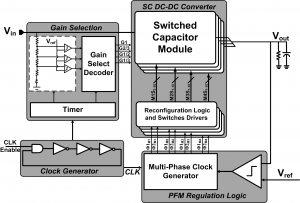
A recent research paper from Microsystems Technology Labs (from MIT) talks about the design technique called switched-capacitor dc/dc converter that may be useful for power conversion because it aims to eliminate the need for inductors. The downside of most research shows that the switched-cap converter is limited by the conduction loss, parasitic capacitance, gate drive loss, and overhead of the control circuits. This paper looks into on-chip ferroelectric caps and multi-gain-setting converters with dynamic gain selection. It shows promise with 93% system efficiency and an output voltage range from 0.4 to 1.1 V. For more information, go to http://www-mtl.mit.edu/wpmu/ar2013/a-93-efficiency-reconfigurable-switched-capacitor-dc-dc-converter-using-on-chip-ferroelectric-capacitors/.

Switched-capacitor architecture
Another paper from the Research Journal of Engineering Sciences describes basic dc/dc converter control techniques. It includes the well-known voltage-mode, current-mode, PID, sliding-mode, and fuzzy-logic control techniques. What makes this interesting is the discussion of advantages/disadvantages of each technique, as well as the basic operating principles. For more information, see http://www.isca.in/IJES/Archive/v2/i8/4.ISCA-RJEngS-2013-099.pdf.
Advertisement





